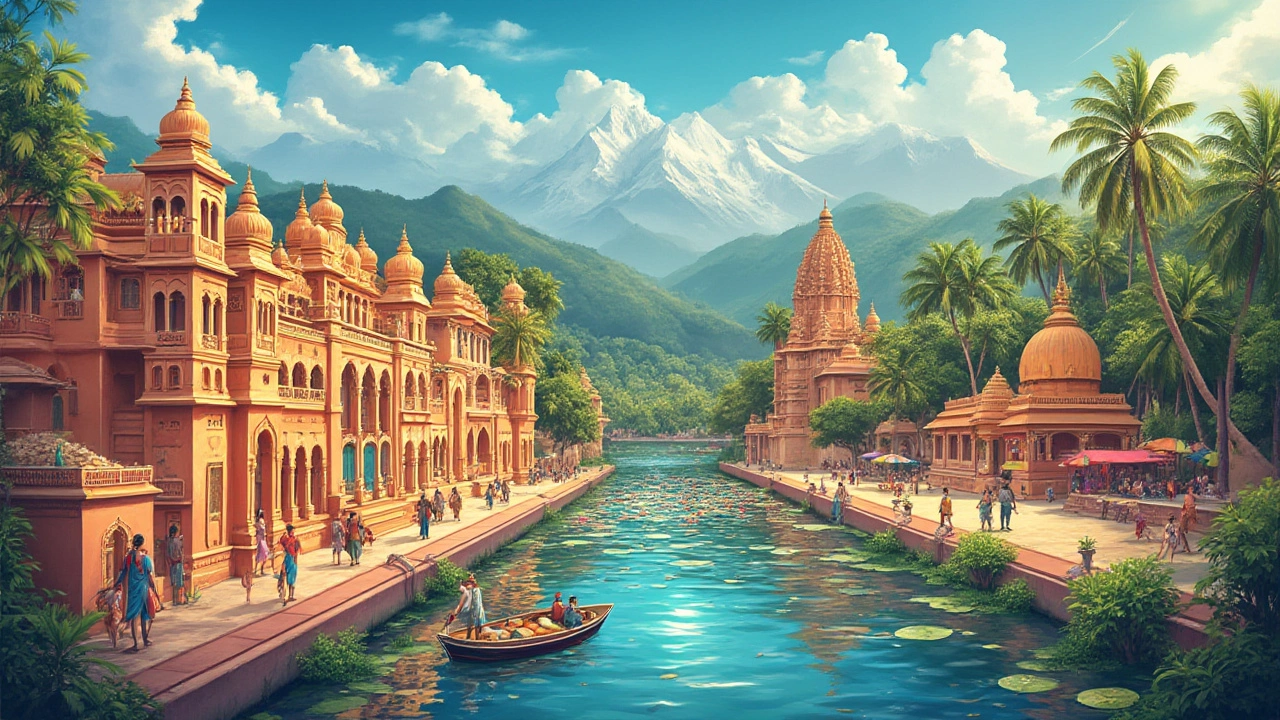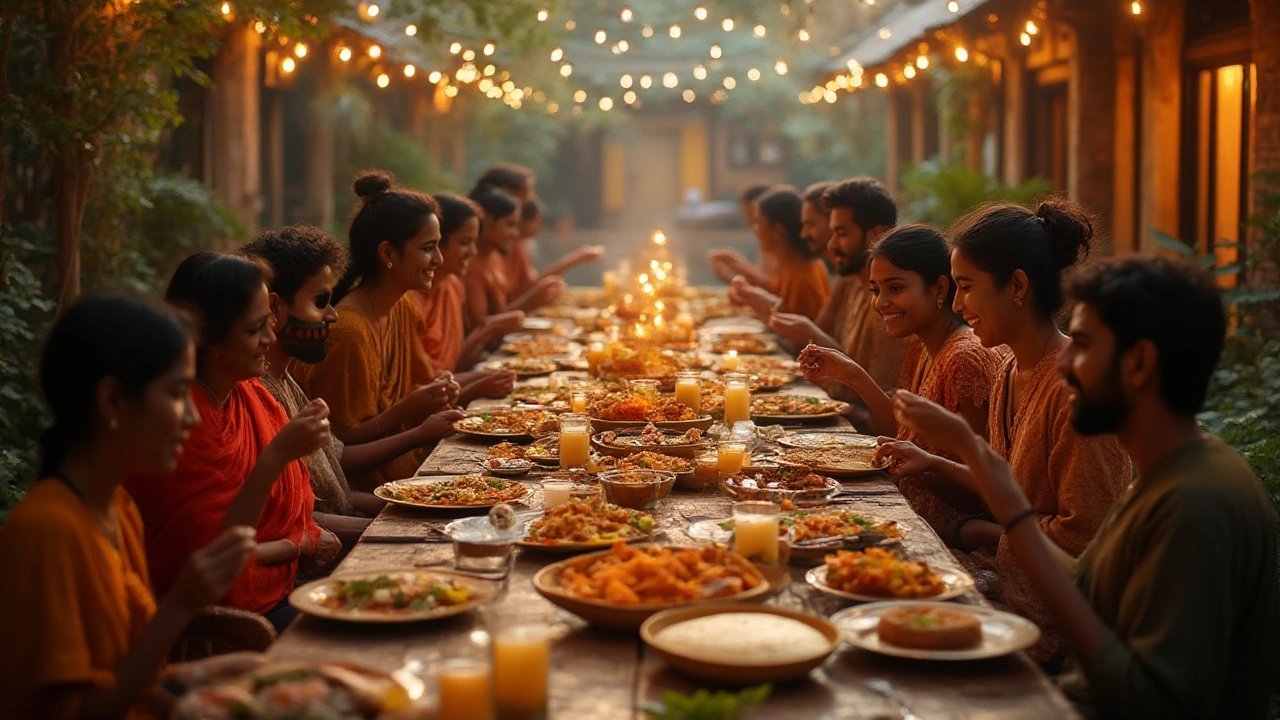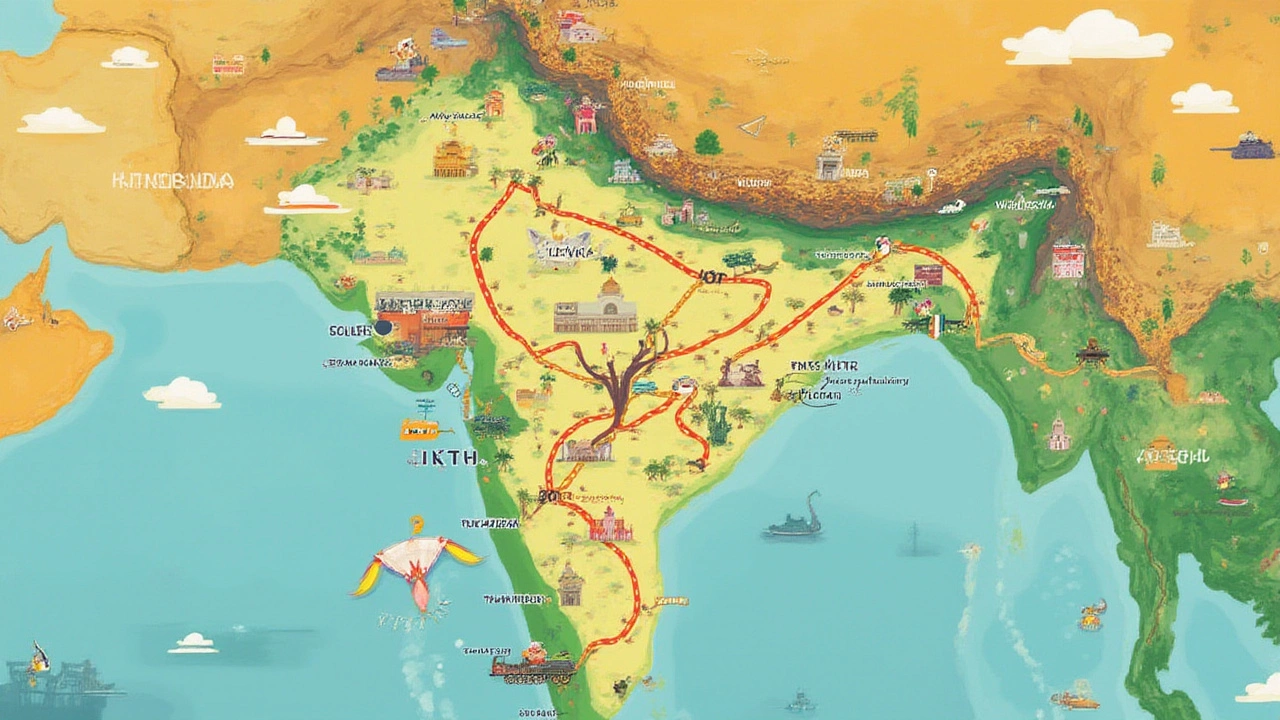North vs South India: Which Region Should You Explore First?

- Jul, 22 2025
- 0 Comments
- Aaron Blackwood
If you’ve ever sat on a rooftop in New Delhi during Holi and watched the city explode with color, you already know that India isn’t a monolith. It shouts its diversity out loud. Yet, mention you want to take a trip there and someone will always hit you with a loaded question: North or South India—which one’s better? It’s a real head-scratcher and not just because there’s so much going on in each. Both regions are gigantic, distinct, and loaded with reasons to tempt any serious traveler—the stuff that fills travel blogs, photo albums, and daydreams. But let’s not pretend it’s an easy pick.
Instead of telling you there’s no wrong answer and calling it a day, I’ll break it down how you might actually want to think about it if you’re making this call. This isn’t one of those "one is spicy, one is mild" cliché breakdowns. We’re talking street scenes, lost temples, over-the-top palaces, mad heat, sea breezes, absurd train rides, and local quirks that make both regions unforgettable (for totally different reasons). Ready your bucket list—and maybe a notebook.
North India: The Grand Stage of History, Chaos, and Legends
The spectacle that is North India feels like it leans in and dares you to keep up. Cities like Delhi, Jaipur, and Varanasi aren’t just dotted with monuments—you’re practically tripping over centuries-old forts, Mughal tombs, and temples humming with rituals. Take Rajasthan: in Jodhpur, the blue city, you can get lost in alleys that feel made for a film. The Mehrangarh Fort towers above, massive and brooding, a proper fortress you can wander all day. Udaipur glimmers with palaces and lakes that’ll make you wonder why royalty ever gave it up.
Icon-hunting? North India’s got the Taj Mahal in Agra, and it’s more breathtaking in real life than any photo tells you. Millions travel each year to see it, and yes, it’s busy, but it also never gets old. Want something quieter? The desert towns of Rajasthan like Jaisalmer still carry legends of old, and the camel safaris out into the Thar will stick with you long after you swipe the dust from your camera lens.
Then there’s spirituality and chaos in perfect harmony, nowhere more obvious than in Varanasi. Pilgrims bathe in the Ganges, funeral pyres burn at dawn, priests chant, monkeys steal everything not nailed down, and the city churns with humanity. You might feel every sense working overtime here. If you want to experience a place where tradition and intensity never slip apart, North India throws you into the heart of it all so you end up loving the messiness.
But it’s not all roaring crowds and swirling traffic. The Himalayas slice across the north, pushing up into the cloud line. Himachal Pradesh and Uttarakhand offer crisp air, hidden villages, and snow peaks. If you’re into trekking, the Valley of Flowers trail is up there with the best. Leh and Ladakh, on the edge of Tibet, feel almost otherworldly—dramatic monasteries, moonscape views, and a slow rhythm you won’t find in Delhi’s chaos.
Hungry yet? You’re in for North India’s gutsy, spice-packed cuisine. Butter chicken, rich curries, tandoor-cooked everything, parathas drenched in ghee, unlimited chai stops—your taste buds won’t forget this in a hurry. Street food is an art form here: chaat in Delhi, kachoris in Rajasthan, and samosas everywhere. If you want proof, consider Chandni Chowk: over 100 food vendors in one stretch, some serving families for generations. If you’re eating vegetarian, you’ll bump into mouthwatering options everywhere thanks to centuries of temple and Jain influence.
Practical tip: North India runs on trains. You get sleeper class windows flung open to the plains or the mountain slow-crawls rattling into Shimla. Tickets get snapped up on the Indian Railways site in minutes, so planning ahead pays off.
North India is a show. Here, history smacks you in the face and the present is electric. It’s loud, captivating, and sometimes overwhelming, but that’s what keeps travelers coming back for more.
| City | Main Attraction | Average January Temp (°C) | Best Street Food |
|---|---|---|---|
| Delhi | Red Fort, Chandni Chowk | 14 | Chaat, Parathas |
| Jaipur | Amber Fort, Hawa Mahal | 15 | Kachori, Lassi |
| Varanasi | Ganga Aarti, Ghats | 16 | Kachori Sabzi, Lassi |
| Agra | Taj Mahal, Agra Fort | 14 | Petha, Bedai |
| Leh | Hemis Monastery, Pangong Lake | -3 | Thukpa, Momos |

South India: Adventure, Ancient Temples, and Laid-back Charm
Head south, and the scenery, the pace, even the smells start to shift. Palm trees edge highways, coconut groves line the fields, and the air carries a whiff of spiced curries and fresh sea breeze. South India is as lush as it gets—Kerala’s backwaters look like they’re from a postcard, and the hill stations like Munnar and Ooty roll out acres of tea plantations that soak up the morning mist. Even the chaos in the cities feels softer somehow. Bangalore has night markets full of dosas sizzling on griddles, and Chennai’s beach vibes pulse through till midnight.
The temples here are masterpieces—giant, color-splashed, and busy with rituals dating back over a thousand years. The Meenakshi Temple in Madurai is a mind-boggling sprawl of 14 towers, each plastered with carvings of gods, demons, and dancers. Hampi is another kind of wonder: a city of ruins strewn across boulders like someone spread them out for an epic storytime session. You can easily spend three days exploring its ancient stone temples, monkey troops, and climbing for sunset views with barely a tourist in sight if you time it right.
South India’s coast means beaches, too. In Kerala, houseboats drift down the Alleppey backwaters, so you can float past kingfishers and rice paddies and fall asleep to the slap of water on wood. If you’re after sand and serenity, Varkala Beach draws a mellow crowd—surfers, soul-searchers, and plenty of locals fishing at sunrise. Over in Goa (yes, technically “west”, but it speaks fluent South), trance parties still happen, but you’ll also find Portuguese churches, chic cafes in Panjim, and yoga studios everywhere.
Cuisine in the south doesn’t mess about. You get thin, crispy dosas bigger than your arm, fluffy idlis, and coconut-based curries that go lighter on the heavy cream. Try thali—endless plates of rice, sambar, spicy pickle, and crispy papad. Fish fans get hooked in Kerala or coastal Karnataka with spicy, tangy meen curry. Coffee? South Indian filter coffee is served strong enough to make a Kiwi wake up at 5am. Even the fruit’s exotic: jackfruit, sapota, custard apple, mangoes you’ll probably dream about by the time you’ve left the subcontinent.
South India is big on nature, too. The Western Ghats are a biodiversity jackpot. Nilgiri tahr graze on the upper slopes, and you can spot elephants in Bandipur and Nagarhole national parks (with some patience and luck). Monsoon season turns everything emerald, so pack a raincoat, but those waterfalls—Athirappilly, Jog, and so many more—make it worth it. If temples leave you cold and you’d rather kayak the day away, Kanyakumari at India’s southern tip gets you sunrise, sunset, and moonrise all over the open water.
Travel here moves slower. Long, winding trains connect the bigger cities, and overnight buses are a rite of passage (okay, they’re not always fun, but you get a story out of it). Flights cut down the hours, but you’ll want to take your time. Locals say the best way to explore Tamil Nadu’s temple towns is in a rhythm: one day spent wandering, one spent eating, one napping in a hammock.
- Tip: Dress code is real at temples—shoulders and legs covered, and sometimes you’ll have to leave shoes behind a mile away. Cotton clothing rules, especially in summer.
- If you’re vegan or vegetarian, South India’s options will spoil you. Even the smallest tea stall can whip out a legit meal without a trace of meat or egg.
- Festivals change everything: Onam in Kerala features feasts on banana leaves and Vallam Kali (snake boat races) that pull in whole villages. Pongal in Tamil Nadu brings sugarcane treats and colorful street art.
| State | Main Attraction | Average January Temp (°C) | Must-Try Dish |
|---|---|---|---|
| Kerala | Backwaters, Munnar, Fort Kochi | 28 | Appam and Stew |
| Tamil Nadu | Meenakshi Temple, Pondicherry | 26 | Dosa with Sambar |
| Karnataka | Hampi, Coorg | 25 | Bisi Bele Bath |
| Andhra Pradesh | Amaravati, Araku | 23 | Andhra Chicken Curry |

Which One Wins? The Art of Choosing Your India
The most stubborn truth: neither North nor South India is "better." They’re simply different, and if you’re hungry for new experiences, you’ll never regret choosing either. Still, everyone wants clues for which to pick on a first (or fiftieth) trip.
If you want a fairytale of palaces, deserts, Himalayan drama, and a feeling of walking alongside history’s greatest stories, go North. It’s the kind of place where a short taxi ride can take you from Mughal grandeur to open-air spice markets, then drop you at bazaars bursting with color. Perfect for anyone who loves a dose of adrenaline with their temples and tales. Eyeing snowy mountain treks and epic fort views? You can’t beat Himachal Pradesh, Ladakh, or Rajasthan for sheer storytelling power.
If you’re more into open spaces, tranquil water, beach sunsets, and food that arrives on a banana leaf, the South calls your name. It’s lush, friendly, and lets you breathe a bit deeper. Even big cities here feel relaxed after a stint in the North, and each state—Kerala, Karnataka, Tamil Nadu, and Andhra Pradesh—packs its own crowd-free wonders and culinary surprises. If you like a steady rhythm and a slightly easier entry into Indian life, South India often feels less stressful for newbies (but no less eye-popping for pros).
Culture-wise, both regions are goldmines. North India’s festivals blast life from every rooftop—think Diwali’s fireworks, Holi’s paint bomb battles—and its languages span Hindi to Urdu and dozens more. The South sings in Malayalam, Tamil, Kannada, and Telugu, turning street signs into a linguist’s dream. Music here means Carnatic concerts and temple drumming under fairy-lighted trees. The North pulls you in with Qawwalis at Sufi shrines, folk songs by desert fires, and Bollywood beats in wedding season.
If you’re mapping your budget, both regions offer everything from shoestring backpacking to five-star luxury. North India has more obvious high-end palaces-turned-hotels. South India’s eco resorts and beachside bungalows mean you don’t have to spend big for bliss. Transport costs are similar; food prices often lower in the South.
Here’s a quick table for comparison:
| Feature | North India | South India |
|---|---|---|
| Main Languages | Hindi, Punjabi, Urdu | Tamil, Malayalam, Kannada, Telugu |
| Must-See | Taj Mahal, Himalayas, Golden Temple, Jaipur | Kerala backwaters, Hampi, Madurai, Pondicherry |
| Best Season | October to March | November to February |
| Best for | History, architecture, trekking, bustling cities | Nature, beaches, ancient temples, relaxed pace |
| Travel Style | Adventurous, energetic | Laid-back, scenic, soulful |
Simple tip? Flip a coin—or just let your gut (and maybe your next craving for spicy chaat or dosas) decide. Either way, India won’t disappoint. If you can manage it, plan to hit both: start in the North to get your mind blown, then head South for the reset. Or swap it—everyone’s path is different. Don’t overthink it. Just go. India’s waiting. And it’ll be even better than you dreamed.